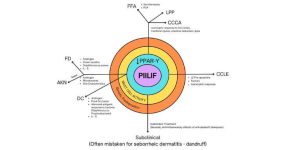What is PIILIF (Perifollicular Infundibulo-Isthmic Lymphocytoplasmic Infiltrates and Fibrosis)? It is a dermatological condition characterized by inflammation of hair follicles, hair loss, and scalp scarring. Recent research suggests that the condition affects scalp hair and other non-scalp hair follicles. In rare cases, PIILIF might involve the eyebrows, eyelashes, beards, and pubic regions.
Perifollicular Infundibulo-Isthmic Lymphocytoplasmic Infiltrates and Fibrosis is often ignored and mistaken for seborrheic dermatitis or dandruff, especially in cases where patients fail to manifest clinical symptoms.
What Causes PIILIF?
Researchers have not yet established the cause of Perifollicular Infundibulo-Isthmic Lymphocytoplasmic Infiltrates and Fibrosis. It likely signifies a low-level autoimmune attack of the hair. It is likely the precursor to currently recognized autoimmune scarring alopecias such as lichen planopilaris – LPP, frontal fibrosing alopecia – FFA, central centrifugal cicatricial alopecia – CCCA, acne keloidalis nuchae – AKN, Folliculitis decalvans – FD, dissecting cellulitis – DC. PIILIF is largely influenced by several factors, such as;
- Genetics.
- Hormonal. For instance, AKN and DC overwhelmingly affect men at the onset of puberty.
- Environmental Triggers. Exposure to chemicals, allergens, pollutants, trauma, or scalp injuries.
- Scalp location
- Infection/superantigen
Contexts Where Can PIILIF Be Found
Primary Condition
A doctor can diagnose PIILIF as a standalone condition with histopathological features and symptoms such as fibrosis, inflammation, and hair loss. However, it does not necessarily indicate the presence of other underlying conditions.
PIILIF Shared Precursor Condition for Acne Keloidalis Nuchae (AKN) and Primary Cicatricial Alopecias (PCAs)
Understanding the relationship between PIILIF and other Primary Cicatricial Alopecias (PCAs) can help diagnose and manage the conditions early to prevent progression.
A research study by Dr. Sanusi Umar, conducted on 41 male patients suffering from AKN, showed symptoms and signs of PIILIF. Moreover, the signs were also exhibited on the Normal-appearing scalp (NAS), away from the AKN lesions. The findings further highlighted the presence of scarring, inflammation, and scaling on some of the patients’ beards and other hairy body parts. This was evidence that PIILIF is a scalp condition and affects hair follicles in different body parts.

Yet, other studies have established the occurrence of PIILIF in the normal-appearance scalp zones in the following classical scarring alopecia: LPP, CCCA, FFA, AKN, FD, and Dissecting cellulitis.
PIILIF(Perifollicular Infundibulo-Isthmic Lymphocytoplasmic Infiltrates and Fibrosis) Symptoms
- No symptoms
- +/- Hair loss (Alopecia)
- +/- Itching, redness, and inflammation of the scalp
- +/- Scaliness/flaking
In addition, other symptoms may include early stages of Primary Cicatricial Alopecias (PCAs).
How Do You Diagnose PIILIF?
A clinical diagnosis is recommended for PIILIF, as the symptoms may overlap with those of other underlying conditions.
PIILIF diagnosis methods include:
- Physical examination. A specialist will monitor visible symptoms on the scalp and other hairy body parts, such as the beard, eyebrows, and eyelashes.
- Trichoscopy. This method evaluates skin lesions on the affected areas under a magnifying lens and lighting to confirm the presence of PIILIF.
- Biopsy: A sample of hair or scalp skin is observed under a microscope to ascertain the PIILIF condition before prescribing further treatment.
How to Treat PIILIF(Perifollicular Infundibulo-Isthmic Lymphocytoplasmic Infiltrates and Fibrosis)
Although PILLIF cannot be cured, health practitioners have devised several treatment options to manage the condition and prevent its progression.
Another key point to note is that treating Perifollicular Infundibulo-Isthmic Lymphocytoplasmic Infiltrates and Fibrosis requires addressing other possible underlying conditions to counter the diseases in their early stages. This is because underlying conditions more often lead to severe PIILIF.
Treatment options include:
- Oral Medications: Tetracyclines for their anti-inflammatory properties.
- Topical Treatments. Consider Tacrolimus vs Pemicrolimin.
- Oral Supplements: EG Gashee oral.
PIILIF(Perifollicular Infundibulo-Isthmic Lymphocytoplasmic Infiltrates and Fibrosis) Frequently Asked Questions (FAQ)
Can PIILIF be cured?
There is no cure; however, an early diagnosis can prevent progression, and various treatment methods can manage the symptoms.
Should I see a specialist for PIILIF?
Yes. Consult a certified board dermatologist for a proper diagnosis, as it might be a precursor for other diseases.
Finally, you can get a free consultation with Dr. Sanusi Umar through this link: https://dru.com/hair-free-consultation/ or by using the consultation button below.
References
Doche, Isabella, et al. “Acne Keloidalis Nuchae and Folliculitis Decalvans: Same Process Affecting the Follicle or Coexisting Diseases? A Retrospective Study.” International Journal of Dermatology, vol. 58, no. 10, 26 June 2019, https://pubmed.ncbi.nlm.nih.gov/31241169/
Umar, Sanusi, et al. A Retrospective Cohort Study and Clinical Classification System of Acne Keloidalis Nuchae. Vol. 14, no. 4, 1 Apr. 2021. Accessed 17 June 2024.
Umar, Sanusi, et al. “Unveiling a Shared Precursor Condition for Acne Keloidalis Nuchae and Primary Cicatricial Alopecias.” Clinical, Cosmetic and Investigational Dermatology, vol. Volume 16, 1 Aug. 2023, pp. 2315–2327, https://doi.org/10.2147/ccid.s422310. Accessed 17 June 2024.
Wang, Eddy H C, et al. “Primary Cicatricial Alopecias Are Characterized by Dysregulation of Shared Gene Expression Pathways.” PNAS Nexus, vol. 1, no. 3, 11 July 2022, https://doi.org/10.1093/pnasnexus/pgac111.